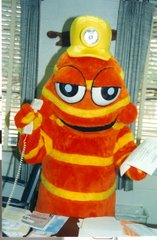
There are scores of programs in cities and counties throughout America where agricultural extension agents, recycling coordinators, naturalists, and other vermiphiles enter classrooms with boxes filled with thousands of worms to introduce children to the living, squiggling laboratory of the earth itself.
One of the most elaborate initiatives, called VermiLab, was developed in 1995 by the Montgomery County, Maryland, Department of Environmental Protection, in cooperation with the public school system, and integrated into the schools' science and social studies curricula. VermiLab was created to bring the natural act of composting closer and more graphically to kids, who then serve as irresistible compost emissaries. The program also strives to raise a child's awareness and curiosity about the web of life which surrounds them: including the invisible though vital life of the soil.
After its first academic term, VermiLab had provided training for 140 elementary, middle, and high school teachers, who brought that knowledge, along with a 2 cubic-foot worm box and 1,000 redworms, back to over 60 schools and 120 classrooms. In fact, interest among teachers was so high that a waiting list was developed for the following year. William N. McDonald, the school system's elementary science coordinator, marvels that "the program creates converts among the teachers." Not only do they overcome their own fear of worms, "they go out and get other teachers involved. And they're all coming up with far more unique projects than I ever envisioned."
 Even in schools which host a single worm box, teachers like David Chia at Georgian Forest Elementary School actually take their show on the road. "After getting my kids worked up for a couple of weeks, I started taking the box into the teacher's lounge. Then I was asked to visit other classrooms." By early March 1996, Chia had visited every classroom in the school, and is currently working to develop a large-scale vermicomposting system in the school's courtyard to handle a ton of food scraps from the cafeteria.
Even in schools which host a single worm box, teachers like David Chia at Georgian Forest Elementary School actually take their show on the road. "After getting my kids worked up for a couple of weeks, I started taking the box into the teacher's lounge. Then I was asked to visit other classrooms." By early March 1996, Chia had visited every classroom in the school, and is currently working to develop a large-scale vermicomposting system in the school's courtyard to handle a ton of food scraps from the cafeteria.
Like Chia, teachers in other classes have worked with their students to get the word out. Some have developed worm newsletters, cultivating young journalists to share their experiences with fellow students throughout the school. And at least one worm box has gone digital, as Frank Sanford's students at Kensington Parkwood developed a worm site on the Internet to exchange information and digital photos with students at a school in St. Louis.
A key element for measuring the success of VermiLab was establishing a requirement for creative feedback from the children -- and teachers. Kindergarten age students were often instructed to create paintings or drawings of worms or worm ecology. Older children kept journals, wrote research papers, and created slide shows. Each student received a tee-shirt with the county's composting logo as a reward for their hard work -- and as a way to turn kids into walking advertisements for composting.
The reports were interdisciplinary and artful. Elementary science classes recorded decomposition rates of various vegetable and fruit foodstuffs, weighed materials, and counted worm populations. And middle school and older science students measured compost Ph and tested comparative plant growth rates of potting mixes using worm compost. Maryvale Elementary School, a popular French immersion program, submitted over 40 colorful folders with essays and poems in French, while other schools stressed mathematics, grammar, and other disciplines in the process of data collection.
In addition to the classroom-based program, where children took turns feeding and caring for their growing worm colonies, a large-scale Worm Garden was built behind the cafeteria of the County's Smith Environmental Education Center. The Center provides several days of training in environmental and natural science studies for thousands of sixth-grade students, and its curriculum now includes a healthy dose of composting.
Students visit a Compost Discovery Garden featuring over 20 backyard composting systems, where they learn to "dissect" a pile and look for compost critters -- the fungi and invertebrates which work with bacteria as decomposer organisms. Later, kids are taken to the Worm Garden, where five large worm boxes accommodate the fruit and vegetable scraps from the mess hall. Children learn that they are part of a big cycle: they will generate the food scraps, weigh them, and then add them to the worm boxes; the worms create compost, which staff and kids will then add to the gardens to grow more food, thus completing the cycle. Lindsey Tschida from Judith Resnik Elementary noted that "you could put food like banana peels, rotten melons, and tea bags in, but no meat." The worms make castings, or compost, and "you put it over your soil and it makes plants and whatever you are growing healthy."
 One of the most noticeable elements in the VermiLab program is Digger Worm, a seven-foot tall, bright orange and yellow worm mascot, originally developed as a cartoon character to lead kids on imaginative expeditions through their worm box. Thanks to high school volunteers, Digger now makes appearances at schools, county fairs, and even the occasional shopping mall. He -- or "it" -- actually receives fan mail from kids often asking the character to come visit a particular school. Digger is a cuddly introduction to worms for younger children, and always travels with a worm-box toting assistant, always eager to show kids some of Digger's smaller relations.
One of the most noticeable elements in the VermiLab program is Digger Worm, a seven-foot tall, bright orange and yellow worm mascot, originally developed as a cartoon character to lead kids on imaginative expeditions through their worm box. Thanks to high school volunteers, Digger now makes appearances at schools, county fairs, and even the occasional shopping mall. He -- or "it" -- actually receives fan mail from kids often asking the character to come visit a particular school. Digger is a cuddly introduction to worms for younger children, and always travels with a worm-box toting assistant, always eager to show kids some of Digger's smaller relations.
The future for VermiLab is looking bright. Another hundred teachers will likely receive training and worm boxes during the next year, and numerous schools are building large, outdoor Worm Gardens to harness cafeteria scraps. A recent Washington Post article on the program generated over 100 calls requesting information -- and worms -- for indoor composting. And Digger Worm is making travel plans for a conference in San Francisco in late December.
The program to date has shared worm composting with over 5,000 students, with 1,800 kids receiving tee-shirts for an amazing range of poems, songs, essays, murals, and science projects. Yet beyond the data and numbers, the love for the soil engendered by worms, large and small, is the greatest payoff for VermiLab. "These worms are good to the world because they eat trash and make rich soil for us to grow plants," observed fourth-grader Brian Shorten, who wisely added, "So if you see a worm don't kill it."
Copyright 2009, Joseph M. Keyser





No comments:
Post a Comment